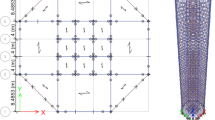Abstract
Mid-America region is defined as the region of the central and southeastern United States compromising those states that have expected large but infrequent seismicity. Although earthquakes in this region are less frequent than in western U.S., they affect much larger areas than those of similar magnitude in western U.S. due to the deep and loose subsurface conditions. However, as little research has been carried out for partially restrained (PR) steel moment frame structures in this region, it is necessary to evaluate their seismic performance. To achieve this, seismic performance of three proto-type 6-story steel moment frames with T-stub PR connections was evaluated in accordance with FEMA 273/356 limit state criteria using fragility analyses. Three PR frames were designed using the appropriate design codes representing mid-1950s, late 1980s, and current practice. Two different types (“Conventional” and “New”) of fragility curves are developed and compared. In addition, the fragility curves at Los Angeles site representing western U.S. were generated and compared with those at the Mid-America region. Two different fragility analysis results show the same trends. Three proto-type 6 story PR frames in the Mid-America earthquake region performed well and may not collapse. It can be concluded that the seismic performance of the mid-rise PR frames in the Mid-America region will be satisfactory even under large but infrequent ground motions.
Similar content being viewed by others
References
AISC (1952). Steel construction manual. 5th Ed. American Institute of Steel Construction.
AISC (1989). Manual of steel construction — Allowable stress design. 9th Ed. American Institute of Steel Construction, Chicago, IL.
AISC (1998). Manual of Steel Construction, Load and Resistance Factor Design Specification for Structural Steel Buildings. Vol. I, Structural Members, Specifications and Codes. 2nd Ed. American Institute of Steel Construction, Chicago, IL.
Anderson, Blume, Degenkolb, Hammill, Knapik, Marchand, Powers, Rinne, Sedgwick, and Sjoberg (1952). “Lateral Forces of Earthquake and Wind.” Transactions, 117, pp. 716–722.
CERI (2001). Center for Earthquake Research and Information. University of Memphis 〈http://www.ceri.memphis.edu/seismic/grabbag/SE_epi.html〉.
Cornell, C. A., Jalayer, F., Hamburger, R. O., and Foutch, D. A. (2002). “Probabilistic basis for 2000 SAC federal emergency management agency steel moment frame guidelines.” J. Struc Eng, 128(4), pp. 526–533.
Disque, R. O. (1971). Applied plastic design in steel, Van Norstrand Reinhold Co., New York.
FEMA (1995). NEHRP recommended provisions for seismic regulations for new buildings and other structures. Parts 1 and 2. Publication No. 222A and 223A, 1994 Ed., Federal Emergency Management Agency, Washington, DC.
FEMA (1997). NEHRP Guidelines for the seismic rehabilitation of buildings. Publication No. 273, Federal Emergency Management Agency, Washington, DC.
FEMA (2000a). Recommended seismic evaluation and upgrade criteria for existing welded steel moment-frame buildings. Publication No. 351, Federal Emergency Management Agency, Washington, DC.
FEMA (2000b). Prestandard and commentary for the seismic rehabilitation of buildings. Publication No. 356, Federal Emergency Management Agency, Washington, DC.
Forcier, G. P. (1994). Seismic performance of older steel frames. Ph.D. Dissertation, Department of Civil and Environmental Engineering, University of Minnesota, Minneapolis, MN.
Foutch, D. A. and Shi, S. (1997). Connection Element (Type 10) for DRAIN-2DX. Internal Report, University of Illinois at Urbana-Champaign, Urbana, IL.
French, S. and Olshansky, R. (2001). Inventory of essential facilities in Mid-America. Mid-America Earthquake Center, MAE Center Publication ID: 74, Thrust and Project: DS, DS-2.
Hwang, H., Jernigan, J. B., and Lin, Y. (2000). “Evaluation of seismic damage to Memphis bridges and highway systems.” J. Bridge Eng., 5(4), pp. 322–330.
IBC (2000) International Building Code. Falls Church, International Code Council, Virginia.
Kim, D. H. and Leon, R. T. (2007). “Seismic performance of PR frames in Mid-America earthquake region.” J. Struc Eng, 133(12), pp. 1808–1820.
Luco, N. and Cornell, C. A. (1998). “Effects of random connection fractures on the demands and reliability for a 3-story pre-Northridge SMRF structure.” Proc. 6th US national conference on earthquake engineering, EERI, Seattle, WA.
Papageorgiou, A. S., Mavroeidis, G., and Halldorsson, B. (2002). Engineering Seismology Laboratory (ESL). State University of New York, Buffalo, NY 〈http://civil.eng.buffalo.edu/engseislab〉.
Schweig, E. S., Gomberg, J., and Hendley, J. W. (1995). The Mississippi Valley-Whole Lotta Shakin’ Goin’On. USGS Earthquake Fact Sheet Series, FS-168-95 〈http://earthquake.usgs.gov/research/external/reports/03HQGR0023.pdf〉.
Smallidge, J. M. (1999). Behavior of bolted beam-to-column T-stub connections under cyclic loading. M.S. Thesis, Georgia Institute of Technology, Atlanta, GA.
Stover, C. and Coffman, J. (1993). Seismicity of the United States, 1568–1989 (Revised). U.S. Geological Survey Professional Paper 1527, Vol. 418.
UBC (1991). Uniform Building Code. International Conference of Building Officials, Whittier, CA.
USGS (2001). Earthquake History of Tennessee. Earthquake Information Bulletin 〈http://earthquake.usgs.gov/earthquakes/states/tennessee/history.php〉.
Wen, Y. K. and Foutch, D. A. (1997). Proposed statistical and reliability framework for comparing and evaluating predictive models for evaluation and design, and critical issues in developing such frame work. Report No. SAC/ BD-9703, SAC Joint Venture, Richmond, CA.
Wen, Y. K. and Wu, C. L. (2000). Earthquake ground motion simulation and Reliability implications. University of Illinois at Urbana-Champaign 〈http://hdl.handle.net/2142/14246〉.
Yun, S. Y. (2000). Performance prediction and evaluation of low ductility steel moment frames for seismic loads. Ph.D. Dissertation, Department of Civil Engineering, University of Illinois, Urbana-Champaign, IL.
Author information
Authors and Affiliations
Corresponding author
Additional information
Note.-Discussion open until August 1, 2013. This manuscript for this paper was submitted for review and possible publication on June 29, 2012; approved on February 19, 2013.
Rights and permissions
About this article
Cite this article
Kim, DH., Leon, R.T. Fragility analyses of mid-rise T-stub PR frames in the Mid-America earthquake region. Int J Steel Struct 13, 81–91 (2013). https://doi.org/10.1007/s13296-013-1008-7
Published:
Issue Date:
DOI: https://doi.org/10.1007/s13296-013-1008-7




